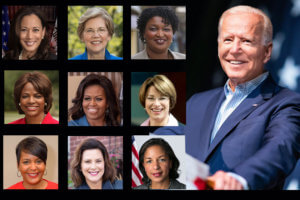West Long Branch, NJ – Hillary Clinton continues to hold a large lead over Bernie Sanders in the South Carolina primary according to the latest Monmouth University Poll . Clinton is seen as the stronger candidate on issues of concern to African-Americans and those who are struggling financially.
Clinton currently holds a 59% to 30% lead over Sanders among those likely to vote in South Carolina’s Democratic primary next week. This is down somewhat from the 69% to 21% lead she held in November, but is still a sizable margin.
Sanders did well in Iowa and New Hampshire because of the overwhelming support he received from younger voters. However, those first two states had almost entirely white electorates. The South Carolina Democratic electorate is expected to be majority African-American. The Monmouth poll finds that Sanders’s appeal to younger white voters does not necessarily translate to younger black voters.
Among white voters under the age of 50, Sanders has a small, statistically insignificant lead of 48% to 44% over Clinton, but among black voters under 50, Clinton has a sizable 60% to 26% advantage. This is only slightly smaller than Clinton’s 69% to 12% lead among black voters age 50 and older and is actually wider than the 59% to 39% lead she holds among older white voters in South Carolina.
“Sanders needs to convince minority voters that his economic inequality message addresses their specific concerns. If he is unable to do that in the South Carolina contest, it could be a very tough road for him in the southern-heavy Super Tuesday contests a few days later,” said Patrick Murray, director of the independent Monmouth University Polling Institute in West Long Branch, NJ.
Sanders does well among voters who identify themselves as independents, leading Clinton by 46% to 43% among this group. However, Clinton holds a large 65% to 24% edge among self-described Democrats likely to vote in South Carolina’s open primary.
Clinton is seen as the candidate who can better address the concerns of African-Americans. Nearly 3-in-4 likely voters say she would do an excellent (33%) or good (39%) job on African-American issues to just over half – 19% excellent and 32% good – who say the same of Sanders. These findings have not changed since Monmouth’s last South Carolina poll in November. Black voters (73%) and white voters (74%) are equally as likely to trust Clinton to handle issues of concern to the black community. However, black voters (43%) are less likely than white voters (58%) to feel the same about Sanders.
The Monmouth University Poll also asked voters what type of job the two candidates would do helping those who are financially struggling. Clinton (27% excellent and 42% good) has a slight edge over Sanders (20% excellent and 40% good) on this score. Her advantage expands, though, among voters earning less than $50,000 a year – 68% rate Clinton positively on this issue and 54% rate Sanders positively.
Looking at the candidates’ fundamental strengths, likely South Carolina primary voters have overwhelmingly positive views of Clinton (76% favorable – 14% unfavorable) and largely positive views of Sanders (61% favorable – 17% unfavorable). The results have changed little from November when Clinton had an 81% – 7% rating and Sanders had a 58% – 13% rating.
Just under one-half (45%) of voters say they are completely decided on their choice – including 56% of Clinton supporters and just 37% of Sanders backers. Another 26% say they have a strong preference but are willing to consider another candidate, 7% register only a slight preference, and 22% say they are really undecided about whom they will ultimately support a week from Saturday.
The Monmouth University Poll was conducted by telephone from February 14 to 16, 2016 with 403 South Carolina voters likely to vote in the Democratic presidential primary. This sample has a margin of error of ± 4.9 percent. The poll was conducted by the Monmouth University Polling Institute in West Long Branch, NJ.
DATA TABLES
The questions referred to in this release are as follows:
(* Some columns may not add to 100% due to rounding.)
1. If the presidential primary election for president was today, would you vote for – [NAMES WERE ROTATED]
| Feb. 2016 | Nov. 2015 | |
| Hillary Clinton | 59% | 69% |
| Bernie Sanders | 30% | 21% |
| (VOL) Other | 0% | 1% |
| Martin O’Malley |
n/a | 1% |
| (VOL) Undecided | 11% | 8% |
| (n) | (403) | (400) |
2. Which of the following best describes where your decision stands at this moment: I am completely decided on which candidate I will support, I have a strong preference right now but I am willing to consider other candidates, I have a slight preference among a group of candidates I like, or I am really undecided among a number of candidates?
| Feb. 2016 | Clinton voters | Sanders voters | Nov. 2015 | |
| Completely decided | 45% | 56% | 37% | 34% |
| Strong preference | 26% | 25% | 37% | 33% |
| Slight preference | 7% | 6% | 9% | 11% |
| Undecided | 22% | 13% | 18% | 22% |
3. Please tell me if your general impression of each of the following candidates is favorable or unfavorable, or if you don’t really have an opinion. [NAMES WERE ROTATED]
| Favorable | Unfavorable | No opinion | |
| Hillary Clinton | 76% | 14% | 9% |
| –November 2015 | 81 | 7 | 12 |
| Bernie Sanders | 61% | 17% | 23% |
| –November 2015 | 58 | 13 | 29 |
[QUESTIONS 4 THROUGH 7 WERE ROTATED]
4. How good a job would Hillary Clinton do addressing the concerns of African-Americans – excellent, good, only fair, or poor?
| Feb. 2016 | Black voters | White voters | Nov. 2015 | Black voters | White voters | |
| Excellent | 33% | 29% | 39% | 31% | 31% | 30% |
| Good | 39% | 44% | 35% | 43% | 44% | 42% |
| Only fair | 19% | 22% | 16% | 16% | 18% | 12% |
| Poor | 6% | 1% | 8% | 2% | 1% | 3% |
| (VOL) Don’t know | 4% | 4% | 2% | 8% | 6% | 13% |
5. How good a job would Bernie Sanders do addressing the concerns of African-Americans – excellent, good, only fair, or poor?
| Feb. 2016 | Black voters | White voters | Nov. 2015 | Black voters | White voters | |
| Excellent | 19% | 14% | 22% | 16% | 8% | 25% |
| Good | 32% | 29% | 36% | 36% | 32% | 41% |
| Only fair | 29% | 34% | 24% | 23% | 32% | 12% |
| Poor | 9% | 11% | 7% | 6% | 7% | 4% |
| (VOL) Don’t know | 14% | 11% | 11% | 19% | 20% | 17% |
6. How good a job would Hillary Clinton do addressing the concerns of those who are struggling financially – excellent, good, only fair, or poor?
|
INCOME | ||||
| Feb. 2016 | <$50K | $50K to $99K | $100K+ | |
| Excellent | 27% | 30% | 19% | 34% |
| Good | 42% | 38% | 48% | 42% |
| Only fair | 20% | 22% | 20% | 16% |
| Poor | 7% | 5% | 11% | 6% |
| (VOL) Don’t know | 4% | 5% | 2% | 2% |
7. How good a job would Bernie Sanders do addressing the concerns of those who are struggling financially – excellent, good, only fair, or poor?
|
INCOME | ||||
| Feb. 2016 | <$50K | $50K to $99K | $100K+ | |
| Excellent | 20% | 14% | 31% | 20% |
| Good | 40% | 40% | 36% | 46% |
| Only fair | 21% | 24% | 19% | 16% |
| Poor | 8% | 9% | 6% | 12% |
| (VOL) Don’t know | 11% | 13% | 8% | 6% |
The Monmouth University Poll was sponsored and conducted by the Monmouth University Polling Institute from February 14 to 16, 2016 with a statewide random sample of 403 South Carolina voters drawn from a list of registered voters who participated in at least one South Carolina primary in 2012 or 2014, or in both the 2012 and 2014 general elections and indicate they will vote in the Democratic presidential primary in February 2016. This includes 264 contacted by a live interviewer on a landline telephone and 139 contacted by a live interviewer on a cell phone, in English. Monmouth is responsible for all aspects of the survey design, data weighting and analysis. Final sample is weighted for age and gender based on state registration list information on the pool of voters who participate in primary elections. Data collection support provided by Braun Research (field) and Aristotle (voter list and non-voter sample). For results based on the total sample, one can say with 95% confidence that the error attributable to sampling has a maximum margin of plus or minus 4.9 percentage points (unadjusted for sample design). Sampling error can be larger for sub-groups (see table below). In addition to sampling error, one should bear in mind that question wording and practical difficulties in conducting surveys can introduce error or bias into the findings of opinion polls.
|
POLL DEMOGRAPHICS (weighted) | |||
| 43% State primary voter | 42% Male | 14% 18-34 |
52% Black |
| 57% Other voter | 58% Female | 27% 35-49 |
44% White |
| 34% 50-64 |
4% Other | ||
| 25% 65+ | |||
Click on pdf file link below for full methodology and results by key demographic groups.




